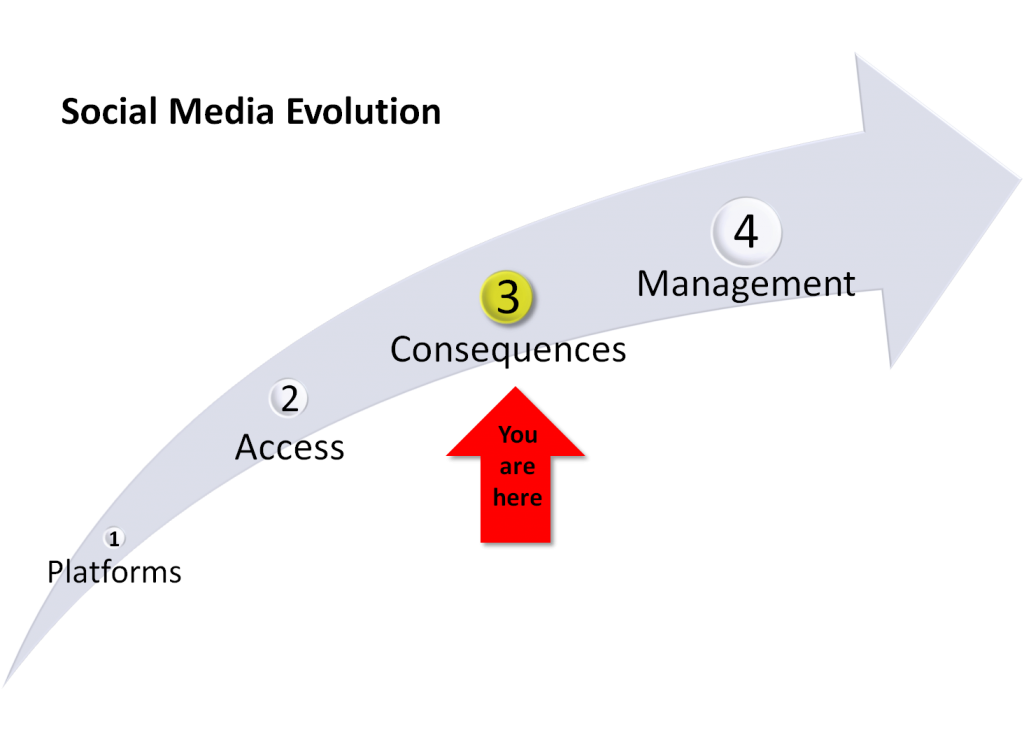We all want to know where we are on the map. Any map. Are we at the start, middle or end of our journey? The big ‘You Are Here’ arrow gives us comfort and helps us get our bearings. Social media is no different, and as of now (June 2011) we’re at ‘Phase 3’ and the ‘You Are Here’ arrow tells us we’re at the ‘Consequences’ phase. But what does that mean?
Phase 1 – the platforms are built
Social media has its earliest origins about a decade ago with the emergence of Wikipedia (2001), LinkedIn (2003), MySpace (2003) – the era when platforms were being developed. They can be characterised by users ‘playing’ and dabbling with the technology. Early adopters jumped on and started testing the water but numbers of users were still low and it was still fairly techie and specialist. Phase 1 was the infancy for social media requiring a high level of knowledge, equipment, connectivity and skill.
Phase 2 – access for the masses
Jump forward a short while and into Phase 2 when the platforms came within everyone’s reach with technology improvements, early PDAs, broadband becoming widely available and easy access for users to try them. This was the dawn of YouTube (2005),Twitter (2006) and Facebook (2006). Big numbers of people signed up and the world started to become social. Apps became reality and online marketing blurred the line across communication disciplines.
Phase 3 – the consequences of creativity
Today, anyone, anywhere can access any platform (within reason), there are no rules and few constraints. This online anarchy (democracy?) is driven by Android, Apple, BlackBerry, The Cloud, Skype and the current smartphone generation. With a click, Phase 3 has exposed businesses who don’t live up to their brand positioning and enabled chaos online. Take a look at the dusty staff handbooks with their old-school directives – remember the days when the rule was ‘personal calls during working hours are not permitted’? Governments can’t contain political and social movements in Egypt, Iran, Libya despite attempts to ‘turn-off’ the channels. Publishers have (largely) lost copyright controls and freedom of speech has taken a leap into the ‘superinjunction-busting’ future.
YOU ARE HERE.
And this is a really uncomfortable place for businesses (read the managers of businesses). Brands and organisations like to control. And until Phase 3 that was still largely possible. Not any more. Social media means that the staff handbook is ready for recycling. If the boss won’t let you use the company phone to speak to someone, hey, I’ll just SMS them from my personal BlackBerry at my desk – or I’ll watch the latest viral YouTube video on my iPhone. Airtime tariffs are cheap and all-inclusive minutes remove the need to use company phones.
Phase 3 is about Consequences. The un-planned, and often unintended reality when anyone can go anywhere and say anything. About you, about your brand and about your business. Groups come together to campaign against things, there is widespread delight when individuals are able to break embargos or post images and news before the planned marketing and PR campaign gets going.
Phase 3 is about the chaos of managing multiple issues across multi media and in real time. ‘No comment’ doesn’t cut it. If you won’t comment, the story doesn’t stall – it just opens the way for staff, suppliers, competitors or anyone else to step in and carry on without you. Scary, eh?
Brian Solis the social media commentator acknowledged as a world leader on the topic writes in his book ‘Engage’ (available here http://bit.ly/bsolenge ) describes this never ending change as a positive opportunity:
‘New media is constantly evolving and has yet to reveal its true impact across the entire business publishing and marketing landscape. We’re only now starting to realise a small portion of its benefits and advantages. In fact new media is only going to become more pervasive and, as such, become a critical factor in the success or failure of any business. We’re just getting started.’
So what’s next?
Phase 4 – management and marketing emerge united
Some brands will get through Phase 3 fairly quickly because social media monitoring technology such as Brandwatch (www.brandwatch.com) or Alterian’s SM2 (http://socialmedia.alterian.com) enables the alert brands to understand the conversations around their brands and develop strategies to address them. This takes them into Phase 4 where organisations decide to manage the activity. Measurement and modification of the business and its culture will ensure they cross to the safe side of the river in fairly short order.
And what does that social media insight look like? Take a look at Brandwatch’s The 5 Most Important Social Media Monitoring Graphs – it’s a helpful insight if you’re new to social media monitoring. http://bit.ly/5keycharts
Phase 4 will be the time that internal debates about ownership of channels, job title and portfolios, staff policies, supplier arrangements, modification of behaviour and training all come together. A culture shift will happen because the business has embraced the online opportunity and will finally be managing the issues rather than trying to force them into the old-school silos.
And after Phase 4?
Well, there will be countless evolutions and changes, but the biggest and most significant is the current ‘Consequences’ phase. Until brands – and that means people running brands – appreciate that ‘You Are Here’ they will live in glorious and potentially dangerous ignorance of the world around them.
But you can do something about all of this. The social media specialists Pebble in the Pond (of which I am an associate) provide the PriSM (Professional Integration of Social Media) programme http://bit.ly/pitpprism which helps businesses move through to Phase 4 recognising the commercial and personnel issues involved in this seismic shift.
My own précis of the key stages in addressing and managing social media can be summed up in the Four Steps To Social Media Management are simple to describe, but challenging to achieve –
- Understand what’s happening in social media around your business and the brands it represents now – a thorough review
- Define the objectives that you want to achieve – it’s a business activity – why should social media by-pass this core issue?
- Create the team to lead the programme (it’s not a ‘one person project’) – and empower them – and make sure they understand business – not just social media
- Measure and manage to achieve results – be regular and consistent
About Al Clarke – I am a marketing and communications specialist who has worked in the motor industry at board level since 1997. I have held senior positions in global brands such as Ferrari and the BBC including a decade working as a journalist.I am a member of the Institute of Directors, the Public Relations Consultants Association, an expert member of the digital community Smart Insights and Life President of the Motor Industry Public Affairs Association.I speak regularly in the field of marketing communications to businesses and the media with particular reference to digital media. Find me on Twitter @alclarkeltd and LinkedIn.


Comments 1
Hi Al
An interesting subject indeed and also interesting to see how the Management of Social Media will evolve over the next few years, with many Companies and Organisations still failing to constructively engage with Social Media.
Your ‘Four Step to Social Media Management’ of Review, Objective, Team Build & Measure make a lot of sense and I do hope that these fundamental management protocols are beginning to be applied in business as the engagement with Social Media is indeed an opportunity not to be missed.
Best wishes
Charles